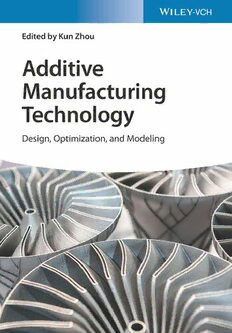
Additive Manufacturing Technology: Design,Optimization and Modeling PDF
Preview Additive Manufacturing Technology: Design,Optimization and Modeling
AdditiveManufacturingTechnology Additive Manufacturing Technology Design, Optimization, and Modeling Edited by Kun Zhou Editor AllbookspublishedbyWILEY-VCHarecarefully produced.Nevertheless,authors,editors,and Prof.KunZhou publisherdonotwarranttheinformation NanyangTechnologicalUniversity containedinthesebooks,includingthisbook, Mechanical&AerospaceEngineering tobefreeoferrors.Readersareadvisedtokeep 50NanyangAvenue inmindthatstatements,data,illustrations, 639798Singapore proceduraldetailsorotheritemsmay Singapore inadvertentlybeinaccurate. CoverImage:©Nordroden/Shutterstock LibraryofCongressCardNo.:appliedfor BritishLibraryCataloguing-in-PublicationData Acataloguerecordforthisbookisavailable fromtheBritishLibrary. Bibliographicinformationpublishedby theDeutscheNationalbibliothek TheDeutscheNationalbibliotheklists thispublicationintheDeutsche Nationalbibliografie;detailedbibliographic dataareavailableontheInternetat <http://dnb.d-nb.de>. ©2023WILEY-VCHGmbH,Boschstr.12, 69469Weinheim,Germany Allrightsreserved(includingthoseof translationintootherlanguages).Nopartof thisbookmaybereproducedinanyform–by photoprinting,microfilm,oranyother means–nortransmittedortranslatedintoa machinelanguagewithoutwrittenpermission fromthepublishers.Registerednames, trademarks,etc.usedinthisbook,evenwhen notspecificallymarkedassuch,arenottobe consideredunprotectedbylaw. PrintISBN:978-3-527-34952-4 ePDFISBN:978-3-527-83391-7 ePubISBN:978-3-527-83392-4 oBookISBN:978-3-527-83393-1 Typesetting Straive,Chennai,India v Contents Preface xi 1 Introductionto4DPrinting:ConceptsandMaterialSystems 1 XiaoKuang,LiangYue,andH.JerryQi 1.1 Background 1 1.2 Overviewof3DPrintingTechniques 3 1.2.1 Single-Material3DPrintingTechniques 3 1.2.2 Multi-Material3DPrinting 5 1.3 Shape-ProgrammableMaterialsfor4DPrinting 7 1.3.1 Shape-MemoryPolymersandComposites 7 1.3.1.1 SingleSMP 8 1.3.1.2 SMPNanocomposites 10 1.3.1.3 PrintedActiveFiber-ReinforcedComposites 11 1.3.1.4 BilayerSMPs 13 1.3.1.5 Multi-materialSMPs 14 1.3.2 HydrogelsandCompositesfor4DPrinting 16 1.3.2.1 Single-MaterialHydrogelsandComposites 17 1.3.2.2 Multi-MaterialHydrogels 18 1.3.3 LiquidCrystalElastomers 19 1.3.3.1 Single-MaterialLCEs 20 1.3.3.2 LCE-BasedMulti-Materials 21 1.3.4 MagnetoactiveSoftMaterials 21 1.3.4.1 SingleMagnetoactiveSoftMaterialComposite 22 1.3.4.2 Multi-materialMSMs 23 1.4 Modeling-GuidedDesignfor4DPrinting 24 1.5 SummaryandOutlook 26 Acknowledgments 27 References 27 2 Strategiesin3DBioprintingofCell-LadenBioinks 43 JunYin,ChangxueXu,ZhengyiZhang,YifeiJin,andYongHuang 2.1 Introduction 43 2.2 Drop-on-Demand(DOD)-BasedInkjetPrinting 46 2.2.1 IntroductiontoInkjetPrinting 46 2.2.2 DropletFormationDuringDODInkjettingofCell-ladenBioink 47 vi Contents 2.2.2.1 BioinkPreparationandExperimentalSetup 47 2.2.2.2 RepresentativeDropletFormationObservations 49 2.2.3 CellDistributionWithinMicrospheresDuringInkjet-BasedBioprinting 50 2.2.3.1 EffectofCellConcentrationonCellDistribution 50 2.2.3.2 EffectofPolymerConcentrationonCellDistribution 52 2.2.3.3 EffectofExcitationVoltageonCellDistribution 53 2.3 LaserPrinting 54 2.3.1 IntroductiontoLaserPrinting 54 2.3.2 EffectsofLivingCellsontheBioinkPrintability 56 2.3.2.1 RepresentativeObservationsDuringLaserPrintingofCell-ladenBioink 56 2.3.2.2 EffectsofLivingCellsonPrintingDynamicsandJettingBehaviors 58 2.3.3 FreeformDrop-on-DemandLaserPrintingof3DAlginateandCellular Constructs 61 2.3.3.1 OverhangConstructFabrication 62 2.3.3.2 BifurcatedAlginate/CellularConstructs 62 2.4 SupportBath-EnabledPrinting-then-SolidificationExtrusion 65 2.4.1 IntroductiontoSupportBath-Enabled3DPrinting 65 2.4.2 Printing-then-SolidificationExtrusionofAlginateandCellular Structures 68 2.4.2.1 Carbopol-EnabledTwo-StepGelationApproach 68 2.4.2.2 3DBioprintingofY-ShapedTubularStructures 68 2.4.3 Printing-then-SolidificationofLiquidMaterialsinNanoclaySuspension 71 2.4.3.1 LaponiteUtilizedastheSupportBathMaterialforExtrusionPrinting 71 2.4.3.2 Gelatin-BasedCellularConstructFabrication 72 2.5 ContinuousPrecuringDigitalLightProcessing(DLP)Printing 74 2.5.1 IntroductiontoDLPPrinting 74 2.5.2 TheoreticalPredictionofDLPWorkingCurveforPhotocurable Materials 77 2.5.2.1 AnalyticalModelofJacobsWorkingCurve 78 2.5.2.2 InfluenceofUVAbsorberConcentration 80 2.5.3 Pre-curingDigitalLightProcessing(DLP)Printing 81 2.5.3.1 TheTunablePre-curingDLPPrintingApproach 81 2.5.3.2 ImprovingDLPPrintingEfficiencybyPre-curingDLPPrinting 82 2.5.3.3 ValidationofPre-curingDLPPrinting 84 2.6 Summary 86 References 87 3 AlloyDesignforMetalAdditiveManufacturing 93 DovgyyBogdanandMinh-SonPham 3.1 AdditiveManufacturing 93 3.1.1 Metal-BasedAdditiveManufacturing 94 3.1.2 AlloyDevelopment 96 3.1.3 AvailableAlloys 97 3.1.3.1 Ti–6Al–4V 99 3.1.3.2 Superalloys 103 3.1.3.3 316LStainlessSteel 107 3.1.3.4 AlSi10Mg 108 3.2 MeltingandCoolingProcessesandAssociatedDefects 110 3.2.1 TheProcess 110 Contents vii 3.2.2 Defects 112 3.2.2.1 SolidificationCracks 112 3.2.2.2 LiquationCracks 113 3.2.2.3 Solid-StateCrackingandResidualStress 113 3.2.2.4 Lack-of-FusionPorosity 114 3.2.2.5 GasPores 114 3.2.2.6 KeyholePorosity 115 3.2.2.7 CompositionalChanges 115 3.2.2.8 Balling 115 3.2.2.9 Summary 116 3.2.3 RolesofMaterialChemical–PhysicalProperties 116 3.2.3.1 Absorptivity/BackscatteringCoefficient 117 3.2.3.2 HeatCapacityandEnthalpyofMelting 117 3.2.3.3 ThermalConductivity 119 3.2.3.4 SurfaceTension 120 3.2.3.5 BoilingTemperatureandVolatility 122 3.2.3.6 ThermalExpansionandContraction 123 3.3 AlloyDesignMethodology 125 3.3.1 KeyholeFormation 125 3.3.2 EvaporationofAlloyingElements 126 3.3.3 BallingDefects 127 3.3.4 SolidificationCrackingModels 128 3.3.5 Solid-StateDefects 129 3.3.6 ModificationstoSolidificationBehavior 131 3.3.7 ExamplesofAlloyDesignforAdditiveManufacturing 133 3.3.7.1 TitaniumAlloyforMedicalApplications 133 3.3.7.2 Creep-ResistantNi-BasedSuperalloy 135 3.3.7.3 HighStrengthCo-BasedSuperalloyforHigh-TemperatureApplications 136 3.4 Summary 139 Abbreviations 140 References 140 4 LaserandArc-BasedMethodsforAdditiveManufacturingof MultipleMaterialComponents–FromDesignto Manufacture 155 ChaoWei,HengGu,ZhizhouZhang,Yuan-HuiChueh,andLinLi ListofAbbreviations 155 4.1 Background 156 4.2 MMAMcomponentsdesign 158 4.3 Multi-materialL-DED 159 4.3.1 IntroductionofL-DED 159 4.3.2 MaterialFeedingMechanisminMulti-MaterialL-DED 161 4.3.2.1 ContinuousCoaxialPowderFeeding 162 4.3.2.2 DiscreteCoaxialPowderFeeding 163 4.3.2.3 SimultaneousWireandPowderFeeding 163 4.3.3 MaterialsandCharacteristicsinMulti-MaterialL-DED 163 4.3.3.1 L-DEDofNi-CuBimetal 164 4.3.3.2 L-DEDofNi–SSBimetal 165 4.3.3.3 L-DEDofTi–AlBimetal 166 viii Contents 4.3.3.4 L-DEDofTi-NiFGMandTi–SSFGMwithDiffusionBarrierLayers 166 4.3.3.5 L-DEDofFe–CuBimetal 167 4.3.3.6 L-DEDofTi-ceramicMaterialSystem 167 4.4 Multi-materialL-PBF 168 4.4.1 IntroductionofL-PBF 168 4.4.2 MaterialDepositionMechanisminMulti-MaterialL-PBF 169 4.4.2.1 UnidirectionalMaterialCompositionVariation 170 4.4.2.2 Spatialmaterialcompositionvariation 170 4.4.2.3 HybridMethodsforDiscretePowderDeposition 171 4.4.3 MaterialsandCharacteristicsinMulti-MaterialL-PBF 173 4.4.3.1 L-PBFofMultipleMetallicMaterials 173 4.4.3.2 L-PBFofHybridMetal/CeramicMaterials 177 4.4.3.3 L-PBFofHybridMetal/PolymerMaterials 178 4.4.3.4 ModelingandSimulationofMulti-MaterialL-PBFProcesses 181 4.5 Multi-MaterialWAAM 183 4.5.1 IntroductionofMulti-MaterialWAAM 183 4.5.2 MaterialFeedingMechanismofMulti-MaterialWAAM 184 4.5.3 MaterialsandCharacteristicsinMulti-MaterialWAAM 184 4.5.3.1 WAAMofSS–Fe/SSBimetals 185 4.5.3.2 WAAMofSS–NiBimetals 185 4.5.3.3 WAAMofTi–AlBimetals 185 4.5.3.4 WAAMofFe–AlBimetals 186 4.5.3.5 WAAMofFe–NiBimetals 186 4.5.3.6 WAAMofCu-involvedMulti-Metals 187 4.6 ComparisonofMulti-MaterialAMTechnologies 187 4.7 PotentialApplicationsofMulti-MaterialAM 188 4.8 ChallengesofMulti-MaterialAMTechnologies 190 4.8.1 ChallengesinMulti-MaterialL-DEDandL-PBF 190 4.8.2 ChallengesinMulti-MaterialWAAM 194 4.9 SummaryandOutlook 196 4.9.1 Summary 196 4.9.2 Outlook 196 References 197 5 ModifiedInherentStrainMethodforPredictingResidual DeformationandStressinMetalAdditiveManufacturing 219 AlbertC.To,XuanLiang,andWenDong 5.1 Background 219 5.2 ModifiedInherentStrain(MIS)Method 220 5.2.1 TheoryforModification 220 5.2.2 RemarksontheISMethod 222 5.3 ExtractionofISsforL-PBFProcess 225 5.4 GoverningEquationsforMIS-BasedSequentialAnalysis 229 5.5 ExperimentalValidation:DoubleCantileverBeam 232 5.6 Simulation-DrivenDesignforL-PBFProcess 235 5.6.1 SupportStructureSelectionforCrackPrevention 235 5.6.1.1 DescriptionoftheWorkflow 235 5.6.1.2 DeterminationoftheCriticalJ-IntegralforSolid/SupportInterface 236 5.6.1.3 CalculationofJ-IntegralatSolid/SupportInterfaceforas-BuiltPart 237
